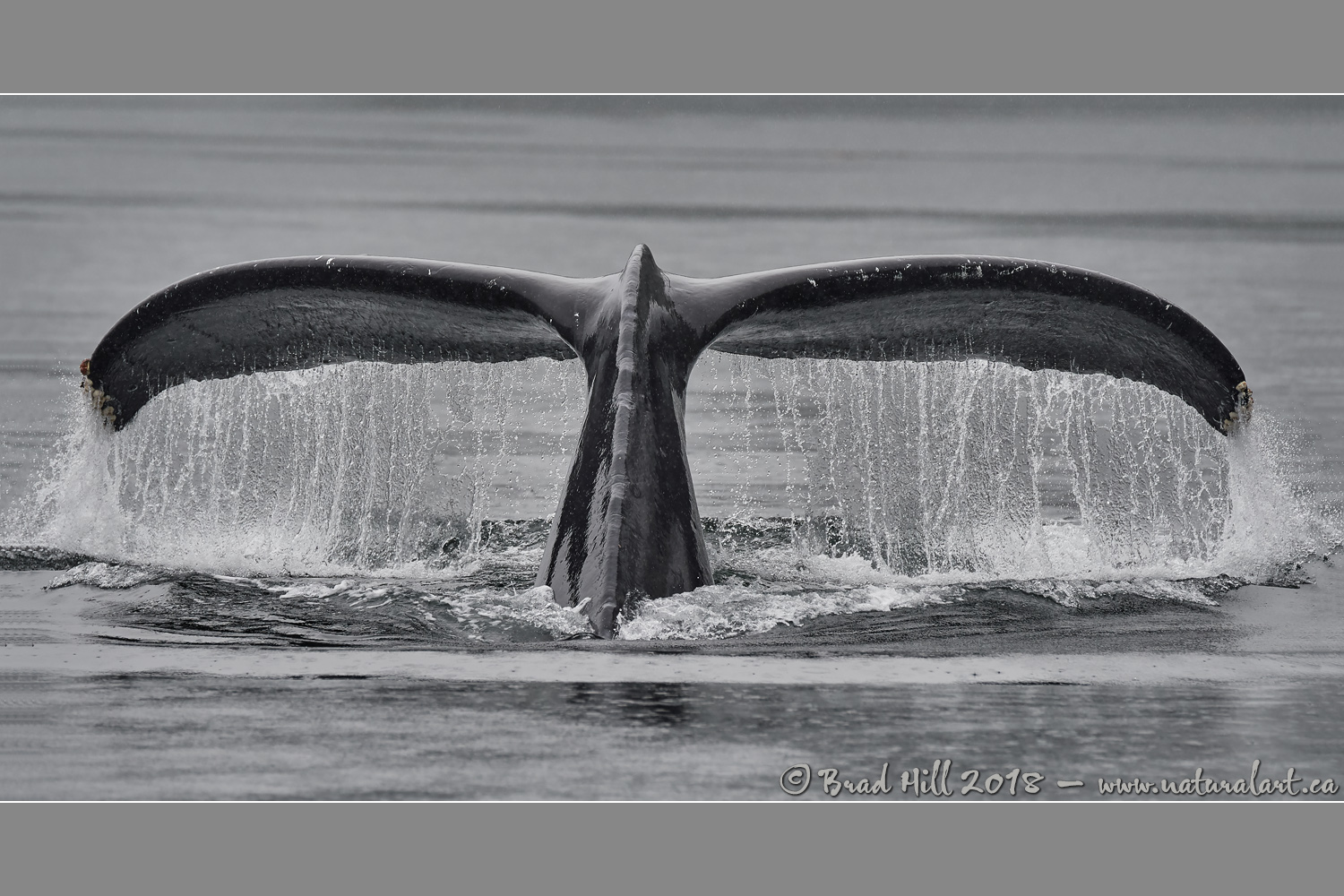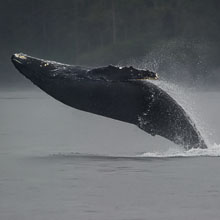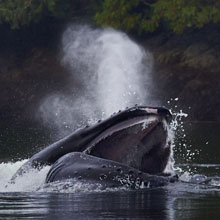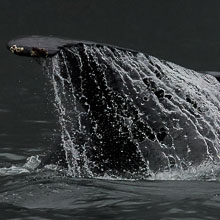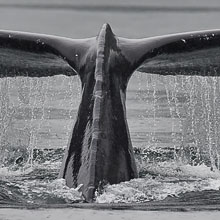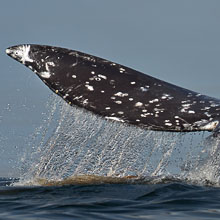Availability: Undetermined - Enquiries?
In the Field
Going Deep! Great Bear Rainforest, Northern BC Coast, Canada. September 22, 2017.
Over the last decade or so there's been a really good thing happen in the coastal inlets and channels of the Great Bear Rainforest - Humpback Whale numbers have dramatically rebounded! I started going to the Great Bear in the autumn of 2005 and back then we'd definitely see a humpback or two on a week-long trip through the inlets and channels of the Great Bear. And, occasionally, we'd see a few whales together. But now we see them virtually anywhere (and everywhere!) in those same inlets and, at times, we have 20 or more of them around our boat. As its name would suggest, the Great Bear Rainforest is best known for its bears, but over the last few years the humpbacks have left as much of a lasting impact on my photo tour clients as the bears have (tho' I have seen some folks really moved by their experiences with Spirit Bears).
From a photographic perspective probably the easiest humpback photo to get is the tail shot. Whenever an adult humpback decides to dive deep (often to get to the small baitfish it eats) they show their tail...so if you have humpbacks around and you have a little time you're bound to see a tail or two - and photographing them isn't too hard. So...with so many whale tail shots kicking around the obvious question (and one I ask myself regularly) is how do you get a tail shot that stands out from the crowd?
After having had literally thousands of opportunities to photograph humpback tails I can say a few things with confidence. In the vast majority of cases you see the tails at a distance and most often they are seen from behind. Occasionally, of course, you'll have a whale at a distance moving directly at you and when it dives, you see a "diving" tail from the "front" side. BUT, until the autumn of 2017, about the only "whale tail" scene I hadn't viewed (or photographed) was a close-up of a whale swimming directly at us and then diving. So...having this whale surface really close to our boat and then swim right at us...well...you can imagine how exciting it was. I knew (or at least hoped!) the whale would choose diving over swimming into us, so I waiting until it arched its back and then showed its tail before snapping off a burst of shots.
I ended up with about 20 frames from this sequence, and this one is my favourite of the batch. I was struck by the detail of the water droplets streaming off the underside of the tail. And, I loved the nuanced lighting on the tail and the "natural monochrome" nature of the scene (the only real colour showing here is on the barnacles on the distal ends of the tail flukes). Note that this is not a black-and-white conversion...I adjusted little other than exposure and contrast in this shot (and it IS full-frame horizontally...thankfully I had a high-quality zoom in my hands and was able to continuously back off the focal length as the whale approached closer and closer).
I'm not about to start a campaign to rename this area the "Great Whale Rainforest"...but anyone contemplating visiting the Great Bear may find themselves enjoying the whales as much as the bears!
Here's a larger (2400 pixel) version of this amazing memory for your perusal:
• Going Deep! Download 2400 pixel image (JPEG: 1.24 MB)
ADDITIONAL NOTES:
1. This image was captured during my "Into the Great Bear Rainforest" Instructional photo tour in the autumn of 2017. Each year I offer photo tours into several different parts of the Great Bear Rainforest as well trips to photograph marine mammals and oceanscapes in locations on the northern portion of Vancouver Island. And, in selected years, I also offer photo tours to locations to capture other highly sought-after subjects, such as Dall Sheep, Bald Eagles, and more. Details about these trips can be found on the Photo Tours page of this website.
2. This image - in all resolutions - is protected by copyright. I'm fine with personal uses of them (including use as desktop backgrounds or screensavers on your own computer), but unauthorized commercial use of the image is prohibited by law. Thanks in advance for respecting my copyright!
3. Like all wildlife photographs on this website, this image was captured following the strict ethical guidelines described in The Wildlife FIRST! Principles of Photographer Conduct. I encourage all wildlife photographers to always put the welfare of their subjects above the value of their photographs.
Behind the Camera
Going Deep! Great Bear Rainforest, Northern BC Coast, Canada. September 22, 2017.
Digital Capture; Compressed RAW (NEF) 14-bit format; ISO 800.
Nikon D500 paired with Sigma Sport 120-300mm f2.8 Sport lens @ 270mm (for an EFL of 405mm). Hand-held from sailboat. OS on and in "OS1" mode, with OS1 stabilization customized to Moderate View mode; AF customized to Fast Priority AF.
1/1250s @ f4.5; +0.67 stop compensation from "recommended" matrix-metered exposure setting.
At the Computer
Going Deep! Great Bear Rainforest, Northern BC Coast, Canada. September 22, 2017.
RAW Conversion to 16-bit TIFF, including all global and selective adjustments, using Phase One's Capture One Pro 10. Selective local adjustments accomplished using Capture One Pro's layers and masking tools. In this case adjustments were made on 3 separate layers and included local/selective editing (or application of) exposure, shadow recovery, and highlight retrieval.
Photoshop adjustments were limited to image re-sizing, conversion of Prophoto RGB colour gamut (to sRGB), final sharpening for online display, and insertion of watermark.
Conservation
Going Deep! Great Bear Rainforest, Northern BC Coast, Canada. September 22, 2017.
Ten percent of the revenue generated by this image will be donated to Raincoast*.
Species Status in Canada**: Threatened - North Pacific population (May 2003).
Humpback Whales (Megaptera novaeagnliae) are active, acrobatic whales that can throw themselves completely clear of the water (a behaviour known as breaching) and will swim on their backs with both flippers in the air. Humpbacks are large (up to 14m - or 46 feet - in length and 40 tonnes in weight) and with huge flippers.
Humpbacks are found in tropical, temperate, and sub-polar waters around the world. They are found on both the east and west coasts of North America. The North Pacific population has been estimated at between 6,000 and 8,000 individuals, but only a few hundred of these are found in the waters off the coast of British Columbia.
While Humpbacks are recovering from the damage done to their populations by commercial fishing, the are still subject to a variety of threats from human activities, including becoming entangled in fishing nets, noise and chemical pollution and habitat destruction.
*The Raincoast Conservation Society (and Foundation) is an effective and efficient organization that has been fighting for protection of this unique habitat. If you are looking for a meaningful way to contribute to the conservation of this amazing ecosystem, Raincoast will provide maximal "bang" for your conservation dollars.
**as determined by COSEWIC: The Committee on the Status of Endangered Wildlife in Canada












